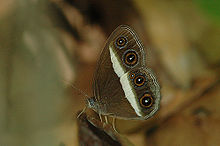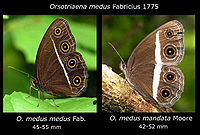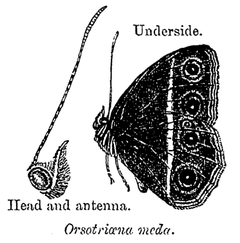- Orsotriaena
-
Orsotriaena medus 
Scientific classification Kingdom: Animalia Phylum: Arthropoda Class: Insecta Order: Lepidoptera Family: Nymphalidae Genus: Orsotriaena
Wallengren, 1858Species: O. medus Binomial name Orsotriaena medus
(Fabricius, 1775)Orsotriaena is a monotypic genus [1][2] of the Satyrinae, or the Browns. The genus has only one species, Orsotriaena medus which is found in Asia and Australia. In India, the butterfly has historically been called the "Nigger",[3] but renamed in Australian faunal works to the socially acceptable name of Smooth-eyed Bush-brown.[4]
Contents
Description
Orsotriaena medus is a medium-sized butterfly with wingspan of 45 to 55mm. The butterfly is dark brown above with a thin marginal pale border with the upper hindwing having a thin submarginal line. There is no eye-spot on the upperside of the wings. Below, the butterfly has a white discal band which runs across both wings. It has five ocelli beloe - two equal-sized eye-spots on the underside of the forewing, an apical ring enclosing two ocelli and two separate ocelli in the tornal region.[5]
Distribution
India, Sri Lanka, Myanmar, Thailand, South Yunnan, Malaysia, Indonesian archipelago, New Guinea, New Britain and Australia.[2]
In India, the butterfly occurs in South India, Punjab, Uttar Pradesh, Bihar, West Bengal, Sikkim, Assam, Nagaland, the Andaman and Nicobar islands.[2][6]
Taxonomy
The butterfly has eight subspecies:[2]
- O. m. medus - N.India to Thailand, Timor, Papua New Guinea, South Yunnan.
- O. m. mutata Butler - New Britain.
- O. m. moira Waterhouse & Lyell, 1914 - Banks Island, Darnley Island, Cape York.
- O. m. mandata Moore - Sri Lanka, South India.
- O. m. cinerea (Butler, 1867) - Sundaland.
- O. m. jopa Hewitson - North Sulawesi.
- O. m. mendice Fruhstorfer - South Sulawesi.
- O. m. paupercula Fruhstorfer - Sula Islands.
Habits
O. medus is very common in the rains up to an altitude of 1600m. A shy, weak-flying insect, it stays low amongst the undergrowth, and when disturbed flies for a short distance before settling down. The butterfly basks in the sun, often with its body aligned parallel to the sun's rays.[5]
Life history
Egg: Not described. Laid on the underside of the leaf.[5]
Larva: "Spindle-shaped, transversely rugose and rough .... two long setose spines on the head pointed forward and two central spines. The colour above is rosy-red with a blue dorsal and a white lateral line, below which the underparts are green."[6]
Pupa: Perpendicularly suspended, slender and regular, except that the head-case is produced into a long beak formed of two thin processes like split straws. Colour whitish brown, with faint striae of a darker shade. It has much the look of a large grain of barley (Davidson & Aitken quoted in Bingham, 1905).[6]
Food-plant: Larva on Oryza sativa, Saccharum officinarum.[2][6] Brachiaria mutica.[7]
Cited references
- ^ Card for Orsotriaena medus in LepIndex. Accessed 19 September 2007.
- ^ a b c d e Marrku Savela's Website on Lepidoptera Page on Orsotriaena genus.
- ^ Evans,W.H.(1932) The Identification of Indian Butterflies, ser no D16.1, pp 123-124
- ^ Australian Faunal Directory, Government of Australia (Dept of Environment & Water Resources) page on Orsotriaena medus [1]. Accessed 20 September 2007
- ^ a b c Haribal, Meena (1992) Butterflies of Sikkim, ser 352, pg 144-145.
- ^ a b c d Bingham, C. T. (1905) The Fauna of British India, Including Ceylon and Burma. Butterflies. Volume 1
- ^ Kalesh, S & S K Prakash (2007). "Additions ot the larval host plants of butterflies of the Western Ghats, Kerala, Southern India (Rhopalocera, Lepidoptera): Part 1". J. Bombay Nat. Hist. Soc. 104 (2): 235–238.
External links
- Review of book on Australian insect names
- Marrku Savela's Website on Lepidoptera [2]
Categories:- Elymniini
- Butterflies of India
Wikimedia Foundation. 2010.



